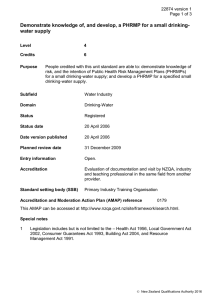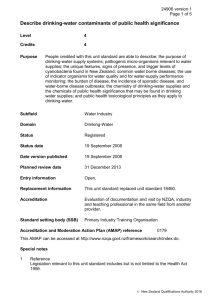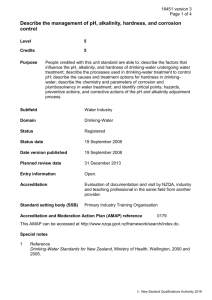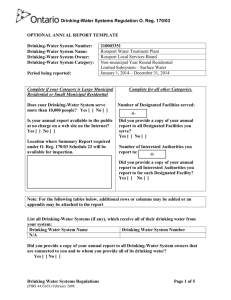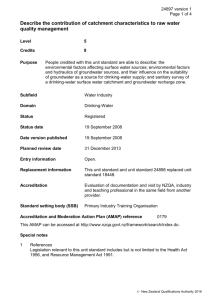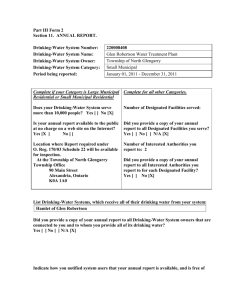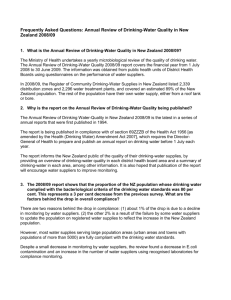Describe the Health (Drinking Water) Amendment Act 2007 relating to
advertisement
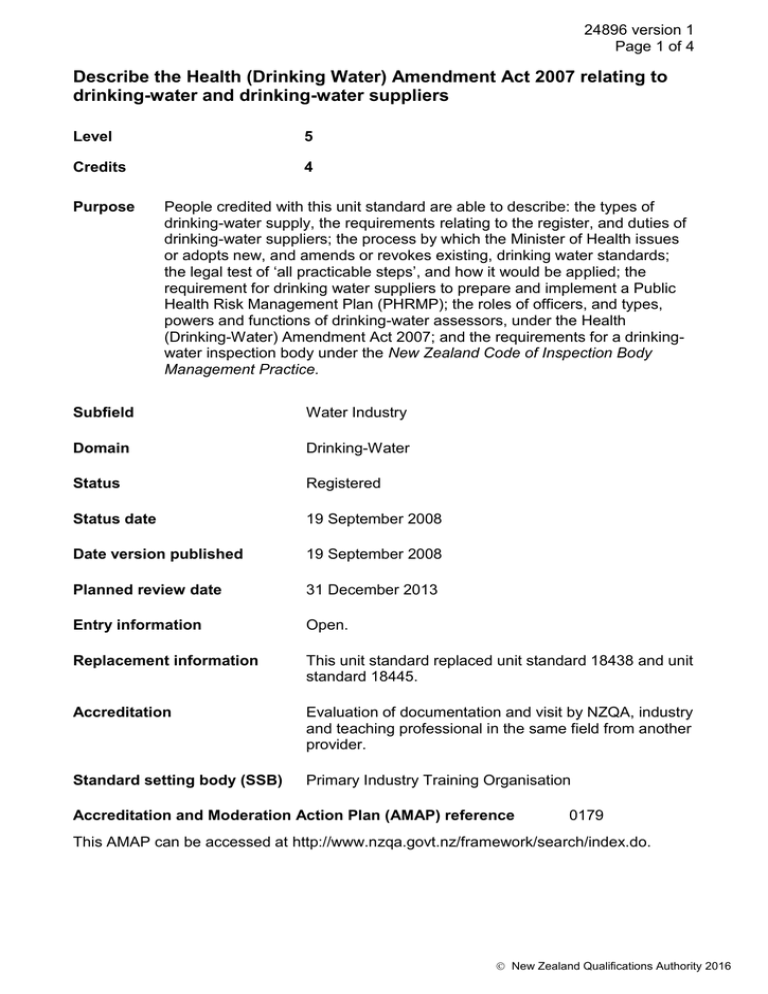
24896 version 1 Page 1 of 4 Describe the Health (Drinking Water) Amendment Act 2007 relating to drinking-water and drinking-water suppliers Level 5 Credits 4 Purpose People credited with this unit standard are able to describe: the types of drinking-water supply, the requirements relating to the register, and duties of drinking-water suppliers; the process by which the Minister of Health issues or adopts new, and amends or revokes existing, drinking water standards; the legal test of ‘all practicable steps’, and how it would be applied; the requirement for drinking water suppliers to prepare and implement a Public Health Risk Management Plan (PHRMP); the roles of officers, and types, powers and functions of drinking-water assessors, under the Health (Drinking-Water) Amendment Act 2007; and the requirements for a drinkingwater inspection body under the New Zealand Code of Inspection Body Management Practice. Subfield Water Industry Domain Drinking-Water Status Registered Status date 19 September 2008 Date version published 19 September 2008 Planned review date 31 December 2013 Entry information Open. Replacement information This unit standard replaced unit standard 18438 and unit standard 18445. Accreditation Evaluation of documentation and visit by NZQA, industry and teaching professional in the same field from another provider. Standard setting body (SSB) Primary Industry Training Organisation Accreditation and Moderation Action Plan (AMAP) reference 0179 This AMAP can be accessed at http://www.nzqa.govt.nz/framework/search/index.do. New Zealand Qualifications Authority 2016 24896 version 1 Page 2 of 4 Special notes 1 Definition Drinking-water supply – the supply catchment, treatment plant, and distribution. The drinking-water supplier has responsibility for managing the public health risks of the drinking-water supply. 2 References Legislation relevant to this unit standard includes but is not limited to the Health Act 1956, and Health (Drinking Water) Amendment Act 2007. The New Zealand Code of Inspection Body Management Practice, available from http://www.moh.govt.nz. Elements and performance criteria Element 1 Describe the types of drinking-water supply, the requirements relating to the register, and duties of drinking-water suppliers, in accordance with the Health (Drinking Water) Amendment Act 2007. Performance criteria 1.1 A drinking-water supplier is defined, and drinking-water supplies are described in terms of their types and features. 1.2 The requirements relating to the register of drinking water suppliers, and the location and sourcing of that information on the register are described. 1.3 The duties of drinking-water suppliers are described. Element 2 Describe the process by which the Minister of Health issues or adopts new, and amends or revokes existing, drinking water standards, in accordance with the Health (Drinking Water) Amendment Act 2007. Performance criteria 2.1 The process by which the Minister of Health issues or adopts new, and amends or revokes existing, drinking-water standards, including consultation and notification, is described. Element 3 Describe the legal test of ‘all practicable steps’, and how it would be applied, in accordance with the Health (Drinking Water) Amendment Act 2007. Performance criteria 3.1 The situations where ‘all practicable steps’ would be applied are described. New Zealand Qualifications Authority 2016 24896 version 1 Page 3 of 4 3.2 The situations where ‘all practicable steps’ would be demonstrated by the drinking-water supplier are described. Element 4 Describe the requirement for drinking water suppliers to prepare and implement a Public Health Risk Management Plan (PHRMP). Performance criteria 4.1 A PHRMP is described in terms of the suppliers who are required to complete one, and the information it must contain. 4.2 A PHRMP is described in terms of the Ministry of Health approval process. 4.3 A PHRMP is described in terms of the time frame for approval by Ministry of Health Drinking-Water assessors. Element 5 Describe the roles of officers, and types, powers and functions of drinking-water assessors, under the Health (Drinking Water) Amendment Act 2007. Performance criteria 5.1 Officers are described in terms of their roles. Range 5.2 Designated Officer, Drinking Water Assessor, Medical Officer of Health. Drinking-water assessors are described in terms of their types, powers and functions as designated by the Director General of Health. Range types – powers and functions, functions and no powers. Element 6 Describe the requirements for a drinking-water inspection body under the New Zealand Code of Inspection Body Management Practice. Performance criteria 6.1 The framework of the New Zealand Code of Inspection Body Management Practice is described in terms of its applications for drinking-water assessors. 6.2 Approved signatories of a New Zealand Accredited Inspection Body are described in terms of their responsibilities. New Zealand Qualifications Authority 2016 24896 version 1 Page 4 of 4 6.3 Roles and associated techniques are described consistent with the requirements of drinking-water assessors and the New Zealand Code of Inspection Body Management Practice. Range audit, inspection, assessment. Please note Providers must be accredited by NZQA, or an inter-institutional body with delegated authority for quality assurance, before they can report credits from assessment against unit standards or deliver courses of study leading to that assessment. Industry Training Organisations must be accredited by NZQA before they can register credits from assessment against unit standards. Accredited providers and Industry Training Organisations assessing against unit standards must engage with the moderation system that applies to those standards. Accreditation requirements and an outline of the moderation system that applies to this standard are outlined in the Accreditation and Moderation Action Plan (AMAP). The AMAP also includes useful information about special requirements for organisations wishing to develop education and training programmes, such as minimum qualifications for tutors and assessors, and special resource requirements. Comments on this unit standard Please contact the Primary Industry Training Organisation standards@primaryito.ac.nz if you wish to suggest changes to the content of this unit standard. New Zealand Qualifications Authority 2016
